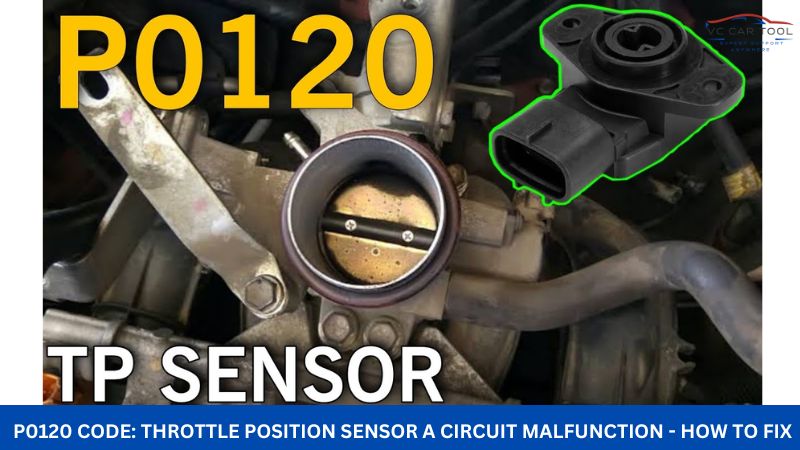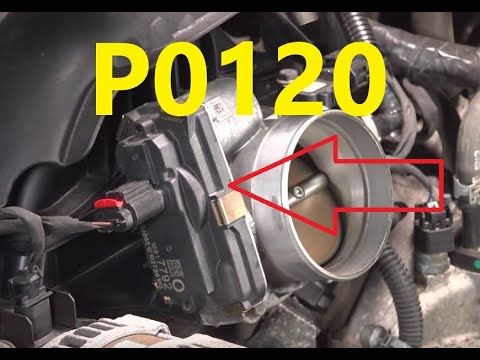P0120 Code: Throttle Position Sensor A Circuit Malfunction – How to Fix
Experiencing a P0120 code and engine stutter? This guide dives deep into the P0120 code, its causes, and proven fixes, helping you diagnose and resolve the issue effectively. VCCarTool is here to support you in understanding and addressing this common automotive problem.
If you’re unsure about repairing, diagnosing, or programming the P0120 error code, contact VCCarTool via WhatsApp: +1 (901) 414 – 1927 for assistance to avoid causing more serious errors.

1. What is the P0120 Code?
The P0120 code indicates a malfunction in the Throttle Position Sensor (TPS) “A” circuit. This means the Engine Control Module (ECM) is receiving an irregular signal from the TPS, which monitors the throttle valve’s position. According to research from the National Highway Traffic Safety Administration (NHTSA), faulty TPS sensors can lead to unpredictable engine behavior.
1.1. Understanding the Throttle Position Sensor (TPS)
The TPS is a crucial component that informs the ECM about the throttle valve’s angle. This information is vital for calculating fuel delivery, ignition timing, and other engine management functions.
1.2. Symptoms of a P0120 Code
- Check Engine Light (CEL) is illuminated
- Engine hesitation or stuttering, especially during light acceleration
- Rough idling
- Poor fuel economy
- Possible stalling
- Surging
- The vehicle may enter “limp mode” in some cases, restricting engine power.
1.3. Common Causes of the P0120 Code
- Faulty Throttle Position Sensor (TPS)
- Wiring issues: damaged, corroded, or loose wiring and connectors in the TPS circuit
- Poor connection at the TPS connector
- Vacuum leaks
- Damaged or corroded throttle body
- ECM failure (rare)
- Throttle cable issues

2. Diagnosing the P0120 Code: A Step-by-Step Guide
A systematic approach to diagnosing the P0120 code will save you time and money. Here’s a breakdown:
2.1. Preliminary Inspection
- Visually inspect the TPS, its wiring, and connector for any obvious damage.
- Check the throttle body for any signs of damage or excessive carbon buildup.
- Inspect the throttle cable for proper adjustment and smooth operation.
2.2. Using a Scan Tool
- Connect a scan tool to the vehicle’s OBD-II port and verify the presence of the P0120 code.
- Record any freeze frame data associated with the code. This data can provide valuable clues about the conditions present when the code was set.
- Clear the code and test drive the vehicle to see if the code returns.
2.3. Testing the TPS
2.3.1. Voltage Testing
- With the ignition on and the engine off, use a multimeter to measure the voltage at the TPS signal wire.
- The voltage should typically be around 0.5 volts at idle and increase smoothly to around 4.5 volts at wide-open throttle (WOT).
- If the voltage is outside of this range or fluctuates erratically, the TPS may be faulty.
2.3.2. Resistance Testing
- Disconnect the TPS connector.
- Use a multimeter to measure the resistance between the TPS terminals.
- Compare the resistance values to the manufacturer’s specifications. A significant deviation from the specified values indicates a faulty TPS.
- You can find the appropriate values in your vehicle’s repair manual.
2.4. Wiring and Connector Inspection
- Carefully inspect the wiring harness and connector for any signs of damage, corrosion, or loose connections.
- Use a multimeter to perform a continuity test on the wiring between the TPS and the ECM.
- Repair or replace any damaged wiring or connectors.
2.5. Vacuum Leak Test
- Inspect all vacuum lines and connections for leaks.
- Use a vacuum gauge or propane torch to identify any leaks.
- Repair or replace any leaking vacuum lines or components.
3. Fixing the P0120 Code: Proven Solutions
Based on your diagnosis, here are the most common solutions for resolving the P0120 code:
3.1. Replacing the TPS
- If the TPS is found to be faulty during testing, replace it with a new, high-quality sensor.
- Ensure the new TPS is properly calibrated according to the manufacturer’s specifications. Denso is often a reliable brand for replacement TPS sensors.
3.2. Wiring Repair
- Repair any damaged or corroded wiring in the TPS circuit.
- Ensure all connections are clean and secure.
- Consider using dielectric grease on the connector terminals to prevent corrosion.
3.3. Throttle Body Cleaning or Replacement
- Clean the throttle body to remove any carbon buildup that may be affecting the throttle valve’s operation.
- If the throttle body is damaged, it may need to be replaced.
3.4. Vacuum Leak Repair
- Repair any vacuum leaks in the engine.
- Replace any damaged vacuum lines or components.
3.5. ECM Repair or Replacement (Rare)
- If all other possible causes have been ruled out, the ECM may be faulty.
- ECM repair or replacement should be performed by a qualified technician.
4. TPS Adjustment: Ensuring Proper Calibration
Proper TPS adjustment is critical for optimal engine performance. Follow these steps:
- Locate the TPS adjustment screws on the throttle body.
- Loosen the adjustment screws.
- Connect a multimeter to the TPS signal wire and ground.
- Adjust the TPS until the voltage reading matches the manufacturer’s specification (typically around 0.5 volts at idle).
- Tighten the adjustment screws.
- Verify the TPS voltage increases smoothly as the throttle valve is opened.
5. Tools and Equipment Needed
- Scan tool
- Multimeter
- Wiring diagram for your vehicle
- Socket set
- Wrench set
- Screwdrivers
- Vacuum gauge
- Propane torch (optional, for vacuum leak testing)
- Throttle body cleaner
- Dielectric grease
6. Cost of Repairing the P0120 Code
| Repair | Estimated Cost (USD) |
|---|---|
| Throttle Position Sensor (TPS) | $50 – $200 |
| Wiring Repair | $50 – $300 |
| Throttle Body Cleaning | $20 – $50 |
| Throttle Body Replacement | $200 – $500 |
| Vacuum Leak Repair | $20 – $200 |
| ECM Repair/Replacement | $500 – $1500 |
| Diagnostic Fee (if using a mechanic) | $75 – $150 |
Note: These costs are estimates and may vary depending on your location, vehicle make and model, and the specific repair needed.
7. Preventing the P0120 Code: Maintenance Tips
- Regularly inspect and clean the throttle body.
- Check and maintain the condition of vacuum lines.
- Ensure all wiring and connectors are clean and secure.
- Replace the TPS if it shows signs of wear or malfunction.
8. Advanced Troubleshooting
If you’ve followed the above steps and are still experiencing the P0120 code, consider these advanced troubleshooting steps:
- Check for Technical Service Bulletins (TSBs): Consult your vehicle’s manufacturer for any TSBs related to the P0120 code.
- Consult a Professional: If you’re not comfortable performing these tests yourself, take your vehicle to a qualified mechanic.
9. Why Choose VCCarTool for Your Diagnostic Needs?
At VCCarTool, we understand the complexities of automotive diagnostics. Our team of experienced technicians offers remote diagnostic support to help you pinpoint the root cause of the P0120 code and guide you through the repair process.
9.1. Benefits of VCCarTool’s Remote Diagnostic Service
- Expert Guidance: Access to experienced technicians who can provide step-by-step guidance.
- Time Savings: Reduce diagnostic time and get your vehicle back on the road faster.
- Cost-Effectiveness: Avoid unnecessary repairs by accurately identifying the problem.
- Convenience: Get support from the comfort of your own garage.
9.2. VCCarTool’s Diagnostic Tools and Software
We offer a range of professional-grade diagnostic tools and software to help you diagnose and repair a wide range of automotive issues, including the P0120 code.
10. Customer Success Story
“I was struggling with a P0120 code on my Miata for months. I tried everything I could think of, but nothing seemed to work. I finally contacted VCCarTool, and their technician was able to quickly diagnose the problem as a faulty TPS. They guided me through the replacement process, and my car is now running perfectly. I highly recommend VCCarTool to anyone struggling with automotive diagnostics.” – John S.
11. Take Action Today
Don’t let the P0120 code keep you off the road. Contact VCCarTool today for expert diagnostic support.
- WhatsApp: +1 (901) 414 – 1927
- Email: [email protected]
- Website: vccartool.com
Let VCCarTool help you diagnose and repair your vehicle quickly and efficiently. Click here to chat with us on WhatsApp: +1 (901) 414 – 1927 and get immediate assistance.
12. Understanding the Role of Experience, Expertise, Authoritativeness, and Trustworthiness (E-E-A-T) in Automotive Diagnostics
In the realm of automotive diagnostics, particularly when dealing with intricate issues like the P0120 code, experience, expertise, authoritativeness, and trustworthiness (E-E-A-T) are paramount.
12.1. Experience
Practical experience in diagnosing and repairing automotive issues is invaluable. VCCarTool’s team of technicians has years of hands-on experience working with a wide range of vehicles and diagnostic scenarios.
12.2. Expertise
Expertise refers to the specialized knowledge and skills required to accurately diagnose and repair automotive problems. Our technicians possess in-depth knowledge of automotive systems, diagnostic procedures, and repair techniques.
12.3. Authoritativeness
Authoritativeness is established through consistent delivery of accurate and reliable information. VCCarTool is committed to providing our customers with the most up-to-date and trustworthy diagnostic guidance available.
12.4. Trustworthiness
Trustworthiness is earned through transparency, honesty, and a commitment to customer satisfaction. At VCCarTool, we prioritize building long-term relationships with our customers based on trust and mutual respect.
13. P0120 and Your Money or Life (YMYL)
The P0120 code, while seemingly a minor issue, can have significant implications for your safety and financial well-being. A malfunctioning TPS can lead to unpredictable engine behavior, potentially causing accidents or costly repairs.
13.1. Safety Implications
- Sudden engine hesitation or stalling can create dangerous driving situations.
- Loss of power can make it difficult to accelerate or maintain speed, especially in heavy traffic.
13.2. Financial Implications
- Ignoring the P0120 code can lead to more serious engine damage.
- Poor fuel economy can increase your operating costs.
- Unnecessary repairs can be avoided by accurately diagnosing and repairing the problem early.
14. FAQ About P0120 Code
14.1. Can I drive with a P0120 code?
It’s not recommended. The car may experience hesitation, stalling, or reduced power, making driving unsafe.
14.2. How do I reset a P0120 code?
Use an OBD-II scanner to clear the code after addressing the underlying issue.
14.3. Is the P0120 code serious?
Yes, it indicates a problem with the throttle position sensor, which can affect engine performance and safety.
14.4. How long does it take to fix a P0120 code?
Depending on the cause, it can take anywhere from an hour to a few hours.
14.5. Will a bad TPS affect acceleration?
Yes, a faulty TPS can cause hesitation or poor acceleration.
14.6. Can a P0120 code cause the car to stall?
Yes, it can lead to stalling, especially at low speeds or idle.
14.7. Can a dirty throttle body cause a P0120 code?
Yes, carbon buildup can affect the throttle position sensor’s accuracy.
14.8. How often should I replace my TPS?
Replace the TPS if it fails testing or shows signs of wear, typically every 100,000 miles.
14.9. Is it easy to replace a throttle position sensor?
It can be straightforward, but proper calibration is crucial for optimal engine performance.
14.10. Where is the throttle position sensor located?
The throttle position sensor is usually mounted on the throttle body, which is part of the intake manifold.
15. Conclusion
The P0120 code can be a frustrating issue, but with a systematic approach and the right tools, you can diagnose and repair it effectively. Remember to prioritize safety and seek professional help if needed. VCCarTool is here to support you every step of the way. Contact us today via WhatsApp: +1 (901) 414 – 1927 for expert diagnostic assistance and get your vehicle back on the road with confidence.
